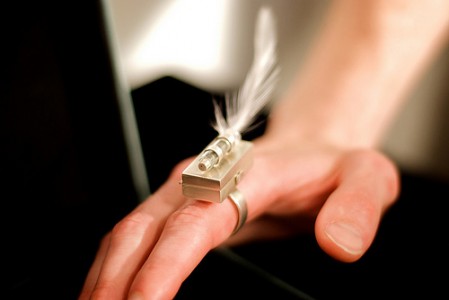The ITP program at NYU always has something cookin' in the wearable technology space. This vid shows what kinds of experiments the students are up to. There are a series of interviews where students who are exploring wearables talk about their projects, what the project's intentions are, and what they see in the future.
Electronic fabrics workshop, July 11
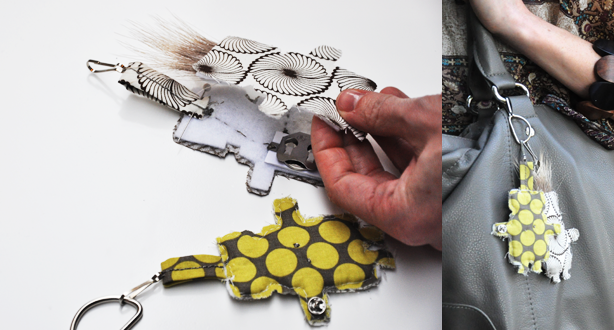 I’m running a wearable technology workshop this weekend at Frayedwire, which will introduce people to soft-circuits and how to work with conductive threads. Here's the workshop:
I’m running a wearable technology workshop this weekend at Frayedwire, which will introduce people to soft-circuits and how to work with conductive threads. Here's the workshop:
Making Electronic Fabrics: Integrating Conductive Thread, LEDs, and Soft Switches into fabrics
This workshop will be a hands-on session focused on integrating electronics into fabrics and making soft switches out of snaps, hooks, zippers and other fashion-hardware. We will be making fashion accessory Palz, soft plush robots that light up when they hold hands. Turn a snap into a switch that turns an LED on and off. All of the circuitry will be sewn directly into the fabric. I'll also be talking a little about the Lilypad (Arduino for wearable technology).
See pics of the workshop and project here.
Generating energy from your wrist
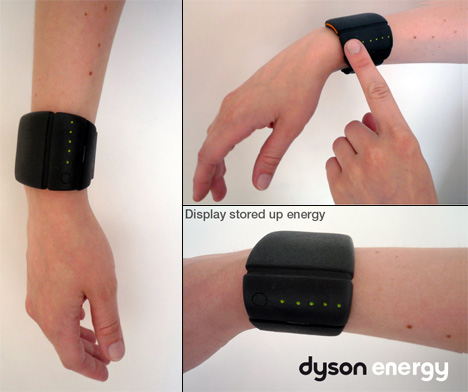 Designers Mathieu Servais, Camille Lefer, Clément Faydi and Mickaël Denié have created the Dyson Energy bracelet that generates power from your wrist. It "uses Seebeck effect to harness energy and power your mobile phones for a few precious minutes more..."
Designers Mathieu Servais, Camille Lefer, Clément Faydi and Mickaël Denié have created the Dyson Energy bracelet that generates power from your wrist. It "uses Seebeck effect to harness energy and power your mobile phones for a few precious minutes more..."
"The thermoelectric effect is the direct conversion of temperature differences to electric voltage and vice versa. This typically includes three separately identified effects, the Seebeck effect, the Peltier effect, and the Thomson effect." source
Finding an alternative source to generate voltage is one amazing accomplishment, but I wonder if the thermoelectric effect will generate enough current to power most devices. This is a terrific concept and I hope the designers continue to push the boundaries on what is possible.
Here's a vid of the concept:
A connection while sleeping
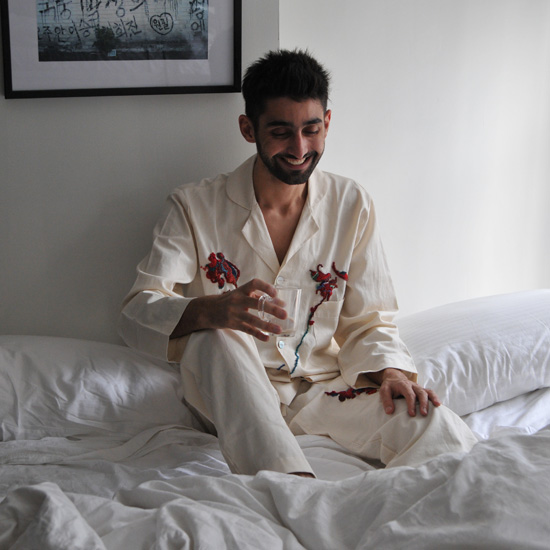 Student Alexander Reeder at the NYU ITP program has created Dream Jammies, which explores the connection that can be made through natural sleep patterns across distances. A pair of pajamas are embedded with sensors that connect to your loved-one's phone. The phone displays an ambient color that represents the state of sleep.
Student Alexander Reeder at the NYU ITP program has created Dream Jammies, which explores the connection that can be made through natural sleep patterns across distances. A pair of pajamas are embedded with sensors that connect to your loved-one's phone. The phone displays an ambient color that represents the state of sleep.
"As you lay down to sleep, the screen fades from green to blue, the shade of blue reflecting your body temperature. As you roll around, the screen flickers red. By shaking the iPhone your partner is able to reach out, causing the chest of your pajamas to vibrate. Not pleasant while you sleep, but a perfect alarm clock. Not only are you able to keep in touch while living on opposite sides of the world, Dream Jammies offer insight into how you sleep by capturing data as you snooze." source
What's cool about this project is that Reeder is exploring how wearable technology can be connected to other devices. He is also considering the aesthetics of the circuitry in the garment itself by integrating the sensors into embroidery.
Vital Jacket monitors heart rate
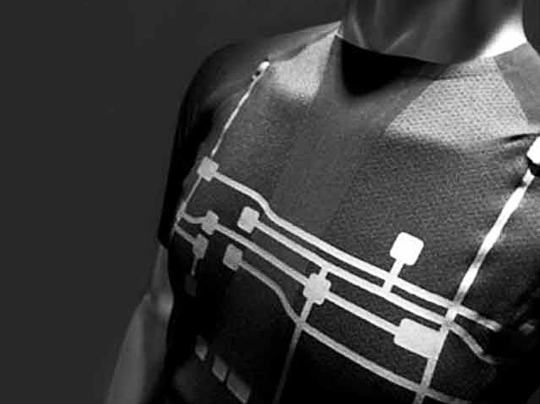 "All sorts of huge machines are used by hospitals to monitor a patient’s vitals, but with the pace in which technology is miniaturizing, there are no real doubts about fabrics becoming the next genuine machines...
"All sorts of huge machines are used by hospitals to monitor a patient’s vitals, but with the pace in which technology is miniaturizing, there are no real doubts about fabrics becoming the next genuine machines...
We’ve seen wearable technology on a maturing track, and the Vital Jacket is yet another case in point. Combining textiles with innovative medical diagnostic technology, BioDevices has unveiled this wearable vital-signs monitoring system." source
I love how this concept is both functional and aesthetically beautiful. They weren't shy about hiding the sensing materials and circuitry and use it as the main aesthetic element. As a runner who uses a hard-cased heart monitor, I would replace that with this product immediately. It provides freedom of movement and it's gorgeous.
For related postings, The Future of Things has a couple of interesting articles about bio-sensors integrated into clothing and the challenges inventors and designers are facing:
Sony Ericsson + cell phone dress
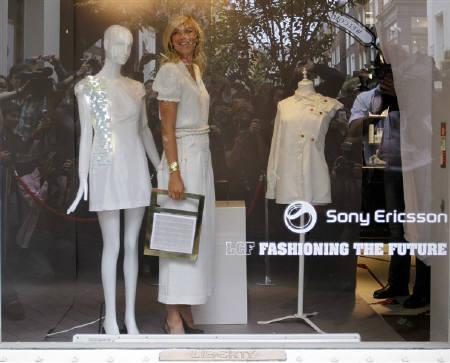 "Former Wimbledon champion Maria Sharapova presented a prototype dress to reporters that is designed to light up when the wearer's mobile telephone rings. British fashion student Georgie Davies dreamed up the knee-length short-sleeved white dress as part of a school project with mobile phone-maker Sony Ericsson to figure out ways of incorporating new technology into fashion.
"Former Wimbledon champion Maria Sharapova presented a prototype dress to reporters that is designed to light up when the wearer's mobile telephone rings. British fashion student Georgie Davies dreamed up the knee-length short-sleeved white dress as part of a school project with mobile phone-maker Sony Ericsson to figure out ways of incorporating new technology into fashion.
Davies said the dress is designed to eventually be connected to the wearer's phone by Bluetooth wireless technology, so she can be alerted to a call even in noisiest of places."
What's cool about this is that the simple concept has gotten so much attention from its Sony Ericsson sponsorship. Someday, concepts like this will hit the mainstream.
via reuters
